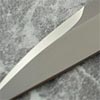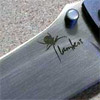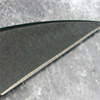Wharncliffe Blade - Blade Geometry
Wharncliffe Blade Info

Description
The Wharncliffe blade, not to be confused with the sheepsfoot blade, is very much like a standard blade shape turned upside down. This type of blade has a totally flat cutting edge, and the spine of the blade drops gradually until the tip forms a point.
There are a few stories as to how the name Wharncliffe came to be, with some people claiming that the pattern originated many years ago from some of the patterns used for Scandinavian Seax Knives and others claiming that it came from a British Lord who commissioned the knife to be made.
There is one thing that is for certain however according to the website of Ron Neep. There were several Lord Wharncliffes that the blade shape could have been named after, but the actual name "Wharncliffe" did not exist prior to 1822, which means it was named after that point in history.
Regardless of history, the Wharncliffe is a very useful blade shape. It is fantastic for office folk for opening boxes and envelopes and excels in box-cutter type chores. It is not very good for preparing food and skinning as the lack of a belly makes it difficult for cutting soft tissue and using on a cutting board.
Coping, Sheepsfoot or Wharncliffe?
Some other confusing things regarding the Wharncliffe blade are the differences between this blade shape and the Coping blade and the Sheepsfoot blade. There is a lot of inconsistencies in naming by companies and which blade is which. It is generally accepted that a Sheepsfoot blade has an abruptly curving spine at the tip of the knife, creating very little point, like a Spyderco Rescue knife, while a Wharncliffe has a more gradually tapering spine creating a pointier tip, and consequently more fragile.
A coping blade is rarely seen in anything besides multi-blade slipjoints and was designed for Electricians to use for cutting details, with the low point allowing for maxium tip control. Occasionally you will see single bladed slipjoints with a coping blade marketed as Electricians Knives.


